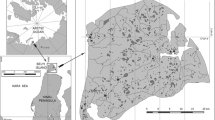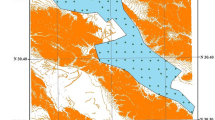Abstract
Soils with elevated arsenic contents are common in the Pannonian Basin. However, little is known about their distribution and occurrence. The subject of this study is the distribution of arsenic in Gleysol developed on an agricultural field in the Podravina region, Croatia. The main objective was to determine which soil parameter has the greatest influence on the overall distribution of arsenic in the area. Mineralogical, geochemical, and physico-chemical characteristics of 56 topsoil samples in were analyzed with statistical analyses, and the spatial distribution of the most important soil parameters was determined and presented. Mineralogical analysis revealed the presence of quartz, plagioclase, clays and micas, and Fe-oxyhydroxide goethite. Geochemical analysis determined elevated contents of iron (max. 23.37 mass. %) and arsenic (max. 824 mg/kg). The spatial distribution of eight parameters indicates overlap in the distribution of iron and arsenic, influenced by the topography of the area. The hierarchical cluster analysis resulted in two main groups: Fe-rich samples (Group 1) and Si-rich samples (Group 2). The Si-rich group of samples has lower arsenic contents, while the Fe-rich group has elevated arsenic contents. This indicates that iron content is the parameter that has the largest influence on the overall distribution of As. Although Fe-oxides can be dissolved under reductive conditions, the predominant presence of well-crystalized goethite implies that As is not mobilized under reductive conditions and remains adsorbed onto goethite mineral phase.





Similar content being viewed by others
Data availability
The data that support the finding of this study are available from the corresponding author upon reasonable request.
References
Ammann L, Bergaya F, Lagaly G (2005) Determination of the cation exchange capacity of clays with copper complexes revisited. Clay Miner 40:441–453. https://doi.org/10.1180/0009855054040182
Banning A (2008) Bog iron ores and their potential role in arsenic dynamics: an overview and a “paleo example.” Eng Life Sci 8(6):641–649. https://doi.org/10.1002/elsc.200800014
Banning A, Rüde TR, Dölling B (2013) Crossing redox boundaries—aquifer redox history and effects on iron mineralogy and arsenic availability. J Hazard Mater 15:905–914. https://doi.org/10.1016/j.jhazmat.2012.12.015
Blodau C, Fulda B, Bauer M, Knorr KH (2008) Arsenic speciation and turnover in intact organic soil mesocosms during experimental drought and rewetting. Geochim Cosmochim Acta 72/16:3991–4007. https://doi.org/10.1016/j.gca.2008.04.040
Brenko T, Borojević Šoštarić S, Ružičić S, Sekelj Ivančan T (2020) Evidence for the formation of bog iron ore in soils of the Podravina region, NE Croatia: Geochemical and mineralogical study. Quat Int 536: 13–29. https://doi.org/10.1016/j.quaint.2019.11.033
Burton ED, Bush RT, Sullivan LA, Johnston SG, Hocking RK (2006) Mobility of arsenic and selected metals during re-flooding of iron- and organic-rich acid-sulfate soil. Chem Geol 253:64–73. https://doi.org/10.1016/j.chemgeo.2008.04.006
California Redlands (2020) E. S. R. I. ArcGIS Pro: Release 2.7
Čobanković I, Habuda Stanić M (2018) Arsenic in Eastern Croatia—problems and solutions. In: Habuda Stanić M, Šiljeg M (eds) 7. međunarodni znanstveno-stručni skup Voda za sve. Prehrambeno-tehnološki fakultet Osijek, Osijek, pp 53–62
Comas-Cufí M, Thió-Henestrosa S. (2011) CoDaPack 2.0: a stand-alone, multi-platform compositional software. In Egozcue JJ, Tolosana-Delgado R, Ortego MI (eds) Proceedings of the 4th international workshop on compositional data analysis, Girona, Spain 2011, 11–13 May 2011
de Mello JWV, Roy WR, Talbott JL, Stuck JW (2006) Mineralogy and arsenic mobility in arsenic-rich Brazilian soils and sediments. J Soils Sediments 6:9–19. https://doi.org/10.1065/jss2005.09.144
Feletar D, Feletar P (2008) The natural basis as a factor of the inhabitation of the Upper Croatian Podravina Region. Podravina 7(13):167–212
Francesconi KA, Kuehnelt D (2002) Arsenic compounds in the environment. In: Frankenberger WT (ed) Environmental chemistry of arsenic. Marcel Dekker Inc., New York, pp 51–94
Galović L (2016) Sedimentological and mineralogical characteristics of the Pleistocene loess/paleosol sections in the Eastern Croatia. Aeolian Res 20:7–23. https://doi.org/10.1016/j.aeolia.2015.10.007
Grisso R, Allex M, Holshouser D, Thomason W (2005) Precision farming tools: soil electrical conductivity. In Virginia Cooper Ext 442–508:1–6
Halamić J, Miko S (eds) (2009) Geochemical atlas of the Republic of Croatia. Croatian Geological Survey, Zagreb, p 87
Head JM (2019) Formal subdivision of the quaternary system/period: present status and future directions. Quat Int 500:32–51. https://doi.org/10.1016/j.quaint.2019.05.018
Hossain M, Islam MM, Rashid SMA, Rahman MM, Rahman M, Sultana S, Ahmed KM, Hasan MA, Bhattacharya P, Jacks G (2010) Delimiting the shallow aquifer characteristics using vertical electrical soundings (VES) and hydrochemical variability in a region with high arsenic groundwater in southeastern Bangladesh. In: Jean J-S, Bhattacharya P, Bundschuh J (eds) Arsenic in geosphere and human diseases. CRC Press, Taylor and Francis, Boca Raton, pp 105–107
Husnjak S (2014) Sistematika Tala Hrvatske. Hrvatska sveučilišna naklada, Zagreb, p 373
IUSS Working Group WRB (2015) World reference base for soil resources 2014, update 2015—international soil classification system for naming soils and creating legends for soil maps. World Soil Resources Reports No. 106. FAO, Rome
Jones CA, Langner HW, Anderson K, McDermott TR, Inskeep WP (2000) Rates of microbially mediated arsenate reduction and solubilization. Soil Sci Soc Am J 64:600–608. https://doi.org/10.2136/sssaj2000.642600x
Kisić I, Nemčić-Jurec J, Bašić F, Zgorelec Ž (2018) The origin of arsenic in soils and groundwater of the Pannonian part of Croatia. Holistic Approach Environ 8:23–36
Kocar BD, Herbel MJ, Tufano KJ, Fendorf S (2008) Contrasting effects of dissimilatory iron(III) and arsenic(V) reduction on arsenic retention and transport. Environ Sci Technol 40:6715–6721. https://doi.org/10.1021/es061540k
Lindberg AL, Goessler W, Gurzau E, Koppova K, Rudnai P, Kumar R, Fletcher T, Leonardi G, Slotova K, Gheorghiu E, Vahter M (2006) Arsenic exposure in Hungary, Romania and Slovakia. J Environ Monit 8(1):203–208. https://doi.org/10.1039/B513206A
Mamindy-Pajany Y, Hurel C, Marmier N, Roméo M (2009) Arsenic adsorption onto hematite and goethite. C R Chim 12:876–881. https://doi.org/10.1016/j.crci.2008.10.012
Mansfeldt T, Overesch M (2013) Arsenic mobility and speciation in a gleysol with petrogleyic properties: a field and laboratory approach. J Environ Qual 42:1130–1141. https://doi.org/10.2134/jeq2012.0225
Masscheleyn PH, Delaune RD, Patrick WH Jr (1991) Arsenic and selenium chemistry as affected by sediment redox potential and pH. J Environ Qual 20(3):522–527. https://doi.org/10.2134/jeq1991.00472425002000030004x
McArthur JM, Banerjee DM, Hudson-Edwards KA, Mishra R, Purohit R, Ravenscroft P, Cronin A, Howart RJ, Chatterjee A, Talukder T, Lowry D, Houghton S, Chadha DK (2004) Natural organic matter in sedimentary basins and its relation to arsenic in anoxic ground water: the example of West Bengal and its worldwide implications. Appl Geochem 19(8):1255–1293. https://doi.org/10.1016/j.apgeochem.2004.02.001
Mitsunobu S, Harada T, Takahashi Y (2006) Comparison of antimony behavior with that of arsenic under various soil redox conditions. Environ Sci Technol 40:7270–7276. https://doi.org/10.1021/es060694x
Munsell AH (1994) Soil colour charts, revised ed. Munsell Color, Baltimore, Md., p 18
Official Gazette NN 71/19 (2019) Regulation on protection of agricultural land in Croatia. No 71/19. Government of the Republic of Croatia, Zagreb
Oremland RS, Stolz JF (2003) The ecology of arsenic. Science 300(5621):939–944. https://doi.org/10.1126/science.1081903
Papić P, Ćuk M, Todorović M, Stojković J, Hajdin B, Atanacković N, Polomčić D (2012) Arsenic in tap water of Serbia’s south Pannonian Basin and arsenic risk assessment. Pol J Environ Stud 21(6):1783–1790
Pavelić D, Kovačić M, Banak A, Jiménez-Moreno G, Marković F, Pikelj K, Vranjković A, Premužak L, Tibljaš D, Belak M (2016) Early Miocene European loess: a new record of aridity in southern Europe. Geol Soc Am Bull 128(1–2):110–121. https://doi.org/10.1130/B31280.1
Petrić H (2009) Fluvial-Aeolian Sands in Croatia. Environmental History Case Study: Djurdjevac Sands (Đurđevački Pijesci). Podravina 8(16):89–97
Pigna M, Caporale AG, Cavalca L, Sommella A, Violante A (2015) Arsenic in the soil environment: mobility and phytoavailability. Environ Eng Sci 32(7):551–563. https://doi.org/10.1089/ees.2015.0018
Popov M, Kudrna J, Lhotská M, Hnilička F, Tunklová B, Zemanová V, Kubeš J, Vachová P, Česká J, Praus L et al (2023) Arsenic soil contamination and its effects on 5-methylcytosine levels in onions and arsenic distribution and speciation. Toxics 11(3):237. https://doi.org/10.3390/toxics11030237
Prelogović E, Velić I (1988) Kvartarna tektonska aktivnost zapadnog dijela Dravske depresije (eng. Quaternary tectonic activity of western part of the Drava basin). Geološki Vjesnik 42:287–299
Rapčan I, Jurišić M, Plaščak I, Barač Ž, Zimmer D, Bognar M (2018) Gnojidba pšenice u sustavu precizne poljoprivrede (eng. Wheat fertilization in a precision farming system). Agronomski Glasnik 3:163–172. https://doi.org/10.33128/ag.80.3.2
Romić Ž, Habuda-Stanić M, Kalajdžić B, Kuleš M (2011) Arsenic distribution, concentration and speciation in groundwater of the Osijek area, eastern Croatia. Appl Geochem 26(1):37–44. https://doi.org/10.1016/j.apgeochem.2010.10.013
Rudnick RL, Gao S (2003) Composition of the continental crust. Treatise Geochem 3:1–51. https://doi.org/10.1016/B0-08-043751-6/03016-4
Shrivastava A, Barla A, Yadav H, Bose S (2014) Arsenic contamination in shallow groundwater and agricultural soil of Chakdaha block, West Bengal, India. Front Environ Sci 2:50. https://doi.org/10.3389/fenvs.2014.00050
Šimunić A, Hećimović I, Avanić R (1993) Basic Geological Map of the Republic of Croatia, M 1:100 000, Sheet Koprivnica (L33-70). Croatian Geological Survey
Smedley PL, Kinniburgh DG (2002) A review of the source, behaviour and distribution of arsenic in natural waters. Appl Geochem 17:517–568. https://doi.org/10.1016/S0883-2927(02)00018-5
Sokolov A (2022) Raspodjela i mobilnost arsena i željeza u profilu tla sa Kalinovca-Hrastove Grede, Podravina. Master’s thesis, University of Zagreb, Faculty of Mining, Geology and Petroleum Engineering, Zagreb, 11 February 2022, p 49
Srivastava S, Srivastava AK, Sablok G, Deshpande TU, Suprasanna P (2015) Transcriptomics profiling of Indian mustard (Brassica juncea) under arsenate stress identifies key candidate genes and regulatory pathways. Front Plant Sci 6:646. https://doi.org/10.3389/fpls.2015.00646
Straub KL, Benz M, Schink B (2001) Iron metabolism in anoxic environments at near neutral pH. FEMS Microbiol Ecol 34:181–186. https://doi.org/10.1111/j.1574-6941.2001.tb00768.x
Šušnjar J (2020) Utjecaj antropogenih onečišćivala na tlo i podzemnu vodu područja Kalinovac-Hrastova Greda. Master’s thesis, University of Zagreb, Faculty of Mining, Geology and Petroleum Engineering, Zagreb, 11 December 2020, p 57
Ujević Bošnjak M, Casiot C, Duić Ž, Fazinić S, Halamić J, Sipos L, Santo V, Dadić Ž (2013) Sediment characterization and its implications for arsenic mobilization in deep aquifers of eastern Croatia. J Geochem Explor 126–127:55–66. https://doi.org/10.1016/j.gexplo.2012.12.017
Varsányi I, Kovacs LO (2006) Arsenic, iron and organic matter in sediments and groundwater in the Pannonian Basin, Hungary. Appl Geochem 21(6):949–963. https://doi.org/10.1016/j.apgeochem.2006.03.006
Waltham CA, Eick MJ (2002) Kinetics of arsenic adsorption on goethite in the presence of sorbed silicic acid. Soil Sci Soc Am J 66(3):818–825. https://doi.org/10.2136/sssaj2002.8180
Weber FA, Hofacker AF, Voegelin A, Kretzschmar R (2010) Temperature dependence and coupling of iron and arsenic reduction and release during flooding of a contaminated soil. Environ Sci Technol 44:116–122. https://doi.org/10.1021/es902100h
Weigand H, Mansfeldt T, Baumler R, Schneckenburger D, Wessel-Bothe S, Marb C (2010) Arsenic release and speciation in a degraded fen as affected by soil redox potential at varied moisture regime. Geoderma 159:371–378. https://doi.org/10.1016/j.geoderma.2010.08.014
Woolson EA (1977) Fate of arsenicals in different environmental substrates. Environ Health Perspect 19: 73–81
World Health Organization (2017) Guidelines for drinking-water quality: fourth edition incorporating the first addendum. WHO, Geneva
Yamaguchi N, Nakamura T, Dong D, Takahashi Y, Amachi S, Makino T (2011) Arsenic release from flooded paddy soils is influenced by speciation, Eh, pH, and iron dissolution. Chemosphere 83:925–932. https://doi.org/10.1016/j.chemosphere.2011.02.044
Acknowledgements
This work has been supported by the Virtulab project (KK.01.1.1.02.0022), co-funded by the European Regional Development Fund.
Funding
This research received no external funding.
Author information
Authors and Affiliations
Contributions
Conceptualization TB, SR and MP; methodology TB and SR; software MP and TB; validation TB, MP and SR; writing—original draft preparation TB and MP; visualization—MP, SR and TB; supervision, TB. All authors have read and agreed to the final version of the manuscript.
Corresponding author
Ethics declarations
Conflict of interest
The authors have no relevant financial or non-financial interests to disclose.
Additional information
Publisher's Note
Springer Nature remains neutral with regard to jurisdictional claims in published maps and institutional affiliations.
Supplementary Information
Below is the link to the electronic supplementary material.
Rights and permissions
Springer Nature or its licensor (e.g. a society or other partner) holds exclusive rights to this article under a publishing agreement with the author(s) or other rightsholder(s); author self-archiving of the accepted manuscript version of this article is solely governed by the terms of such publishing agreement and applicable law.
About this article
Cite this article
Ružičić, S., Puljko, M. & Brenko, T. Spatial and statistical analyses of parameters influencing arsenic distribution in the lowland Drava River area, northeastern Croatia. Environ Earth Sci 82, 403 (2023). https://doi.org/10.1007/s12665-023-11094-9
Received:
Accepted:
Published:
DOI: https://doi.org/10.1007/s12665-023-11094-9




